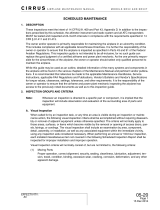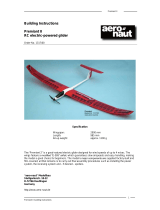Page is loading ...

Jun 30/01
27-21-00
Page 1
EFFECTIVITY:
All
z
SD3-60 AIRCRAFT MAINTENANCE MANUAL
AMM27-21-00 10.0.0.0RUDDER PRIMARY CONTROLS DESCRIPTION & OPERATION
1. Description
A. General
Refer to Figure 1. Rudder movement is controlled by a system of push/pull rods and levers
which directly connect the rudder bars on the pilots floor with an operating lever on the torque
tube at the bottom of each rudder.
The rudder is provided with a trim tab and an associated control system. Refer to 27-22-00,
pb1. The tab also acts in a geared capacity i.e. it responds to assist primary surface
movement.
B. Rudder circuit
Refer to 27-21-01, pb1. Pedal movement on the interconnected rudder pedestals is
transmitted via a vertical torque tube which is coupled to the bottom of the left rudder
pedestal assembly.
The torque tube is provided at the bottom with an output lever from which a series of control
rods (inter-connected by lever assemblies positioned as shown) are routed aft below the
main cabin floor, then up the fuselage left sidewall at frame 315.19 and thence through the
roof structure to connect with the rudder operating lever.
C. Rudder stops
The travel range of the rudders is determined by the setting of adjustable primary stops on
each rudder pedestal assembly. When the primary stops take effect, a clearance exists at the
corresponding secondary stop mounted on the torque tube assembly at the bottom of the
rudder.
The adjustable secondary stops are set to contact resilient buffers on brackets fitted to each
vertical stabilizer when the design travel limit beyond that determined by the related primary
stops is reached.

Jun 30/01
27-21-00
Page 2
EFFECTIVITY:
All
z
SD3-60 AIRCRAFT MAINTENANCE MANUAL
Rudder Primary Controls
Figure 1

Apr 24/03
27-21-00
Page 201
EFFECTIVITY:
All
z
SD3-60 AIRCRAFT MAINTENANCE MANUAL
AMM27-21-00 11.0.0.0RUDDER PRIMARY CONTROLS - MAINTENANCE PRACTICES
WARNING: WHENEVER ANY PART OF THIS SYSTEM IS DISMANTLED, ADJUSTED, REPAIRED
OR RENEWED, DETAILED INVESTIGATION MUST BE MADE ON COMPLETION TO
ENSURE THAT DISTORTION, TOOLS, RAG OR ANY LOOSE ARTICLES OR FOREIGN
MATTER SUCH AS COULD IMPEDE THE FREE MOVEMENT AND SAFE OPERATION
OF THE SYSTEM ARE NOT PRESENT, AND THAT THE SYSTEMS AND
INSTALLATIONS IN THE WORK AREA ARE CLEAN.
THAT PART OF THE SYSTEM DISTURBED AS A RESULT OF MAINTENANCE
PRACTICES PERFORMED SHALL BE SUBJECTED TO A DUPLICATE INSPECTION
FOR SECURITY OF LOCKING DEVICES, FULL AND FREE MOVEMENT AND
DIRECTIONAL SENSING CHECKS.
1. Servicing
A. Lubrication
Routine lubrication data. Refer to 12-22-27, pb301.
2. Adjustment/test
Special tools and equipment:-
Clamp type travel gauge
Rigging pins (as listed):-
T.27.63 or equivalent
R1 (2 off) T360.27.34
R2 T360.27.35
R3 T360.27.36
R4 T360.27.37
R5 T360.27.38
R6 T360.27.39
R7 T360.27.40
R10 T360.27.41

Apr 24/03
27-21-00
Page 202
EFFECTIVITY:
All
z
SD3-60 AIRCRAFT MAINTENANCE MANUAL
A. Rig the controls
Refer to Figure 201 (Sheet 1).
Carry out the procedures referenced below with respect to local linkages throughout the
system to effect complete rigging of the rudder primary controls.
NOTE: After final adjustment of control rod lengths, check that the rod ends are in safety i.e.
threads in evidence through inspection holes, and lock the adjustable fittings with the
nut and tab washer.
Rig between pedals and frame 74.
(1) Disconnect control rods SD3-45-2100 and 2101 (see main view) at adjustable ends.
(2) Insert rigging pins R1 at left and right pedestals (detail A).
(3) Adjust control SD3-45-2100 to suit and reconnect.
(4) Set control rod SD3-45-2101 to 1344 mm between centres and reconnect; this positions
control lever (detail B) at neutral.
Rig below flooring, (FS74 to FS315.19).
(5) Disconnect control rods SD3-45-2102, 6019, 6018, 2104 and 2105 (see main view) at
adjustable ends.
(6) Insert rigging pins R2 and R3 where shown respectively on details C and D.
(7) Set the fixed length control rods SD3-45-2447, 2450 and 2448 (see main view) at their
forward ends to the dimension shown on detail Q. Maintain this setting and adjust the
control rods disconnected at (5) to suit and reconnect.
(8) Set clearance at each roller guide support (detail Q) as follows:-
(a) Remove all rigging pins.
(b) Disconnect control rod SD3-45-2106 where attached to bellcrank (detail D).
(c) Operate rudder pedals throughout range to determine tightest point on adjustable
roller; set roller to provide 0.002 in. clearance at this point. Tighten clamping block.
(d) Again operate throughout range, checking that no gap exceeds 0.008 in. Wirelock
clamping block bolt.
(e) Re-insert rigging pin R3 (detail D).
Rig within left sidewall (fr. 315.19).
(9) Disconnect rods SD3-45-2106 and 6017 (see main view) at adjustable ends.

Apr 24/03
27-21-00
Page 203
EFFECTIVITY:
All
z
SD3-60 AIRCRAFT MAINTENANCE MANUAL
(10) Insert rigging pins R4 and R5 where respectively shown on details E and F.
(11) Adjust control rods to suit and reconnect.
Rig within fuselage roof (FS351.19 to FS625).
(12) Disconnect control rods SD3-45-2108, 2109, 2110, 6078, 6077 and 6080 (see main
view) at adjustable ends.
(13) Insert rigging pins R6, R7 and R10 where respectively shown on details G, H and L.
(14) With reference to main view, set fixed control rod SD3-45-6071 at its forward end to the
dimension shown on detail J and control rods SD3-45-6072 (two off) at their aft ends to
the dimension shown on detail K. Maintain these settings and adjust the control rods
disconnected at (12) to suit and reconnect.
(15) Disconnect control rod SD3-45-6076 (detail L) and set clearance of each roller guide
support (detail Q) in the manner detailed at (8) for those under fuselage floor.
Rigging of levers in rear fuselage (FS625 and FS640.6)
(16) With control rod SD3-45-6076 (see main view) disconnected, insert rigging pin R10
where shown in detail L. Engage control lock to secure detail M in neutral position.
(17) Adjust control rod SD3-45-6076 to suit and reconnect. Rig the rudder and set control
stops
(18) With control lock (detail M) engaged, disconnect control rod SD3-45-6083 (see main
view) at adjustable ends.
(19) Set rudder in neutral position and adjust control rod to suit and reconnect.
(20) Connect rudder travel gauge.
(21) Screw in the adjustable primary stops at the bottom of each rudder pedestal and the
secondary stops at the control surface (detail P).
(22) Remove all rigging pins and disengage control lock.
(23) Move left pedal assemblies forward and adjust the right secondary stop at the rudder to
make contact at the angle indicated (detail P). Maintain this setting and adjust the
corresponding primary stops at each pedestal to contact their respective stop levers.
Lock the primary stops and 'back-off' the secondary stop to obtain the clearance quoted
(detail P).
(24) Repeat (23) with right pedals moved forward and similarly adjust associated primary
stops and secondary stop to limit opposite travel.

Apr 24/03
27-21-00
Page 204
EFFECTIVITY:
All
z
SD3-60 AIRCRAFT MAINTENANCE MANUAL
Complete the rigging procedure.
(25) Remove travel gauges.
(26) Check backlash and circuit friction as detailed in para 3.
(27) Select controls LOCKED and check that all rigging pins can be inserted and withdrawn
freely. Remove rigging pins.
B. Function test rudder primary controls
(1) Select controls LOCKED.
(2) Attach travel gauges to trailing edge of rudder. Adjust to register zero.
(3) Select controls UNLOCKED and operate rudder pedals to extremes of travel in both
directions, checking:-
(a) Directional sensing
(b) That control surface movement agrees with that shown on detail P.
3. Inspection/Check
A. Check rigging
(1) Refer to Figure 201 (Sheet 1). Insert rigging pins R1 at left and right rudder pedals (detail
A)..
(2) Check that when controls are selected LOCKED, the locking lever (detail M) engages.
(3) Remove rigging pins and perform function test detailed in para 2.B. and additionally
check the clearances at the control surface stops (detail P) when, the primary stops at
the rudder pedestals take effect.
B. Check backlash
(1) Suitably lock rudder pedals in neutral position.
NOTE: Do not employ gust lock mechanism for this purpose.
(2) Check backlash by applying a load of 2 Ib. at the trailing edge of the rudder (at right
angles to the surface) first in one direction, then the other.
NOTE: The total backlash evident should not exceed 1°.

Apr 24/03
27-21-00
Page 205
EFFECTIVITY:
All
z
SD3-60 AIRCRAFT MAINTENANCE MANUAL
Rudder Controls - Rigging
Figure 201 (Sheet 1)

Apr 24/03
27-21-00
Page 206
EFFECTIVITY:
All
z
SD3-60 AIRCRAFT MAINTENANCE MANUAL
Rudder Controls - Rigging
Figure 201 (Sheet 2)

Apr 24/03
27-21-00
Page 207
EFFECTIVITY:
All
z
SD3-60 AIRCRAFT MAINTENANCE MANUAL
C. Check circuit friction
(1) Connect a spring balance to the mid position of a left-hand rudder pedal.
(2) Place the pedals in the neutral position.
(3) Slowly pull the pedal back through 10° (maintaining the load parallel to the floor and the
centreline of the aircraft) and record the maximum load necessary to achieve this travel.
Repeat four times and check that the average of the four readings recorded does not
exceed 7 Ib. Return pedals to the neutral position.
(4) Repeat steps (1) to (3) reading right for left.
/


